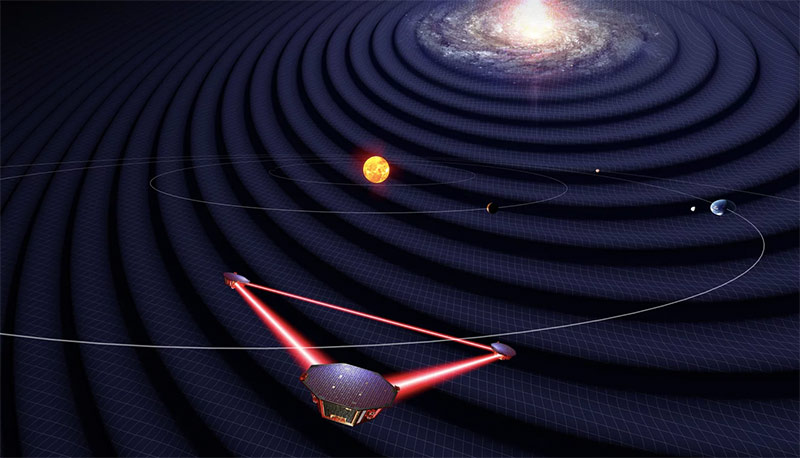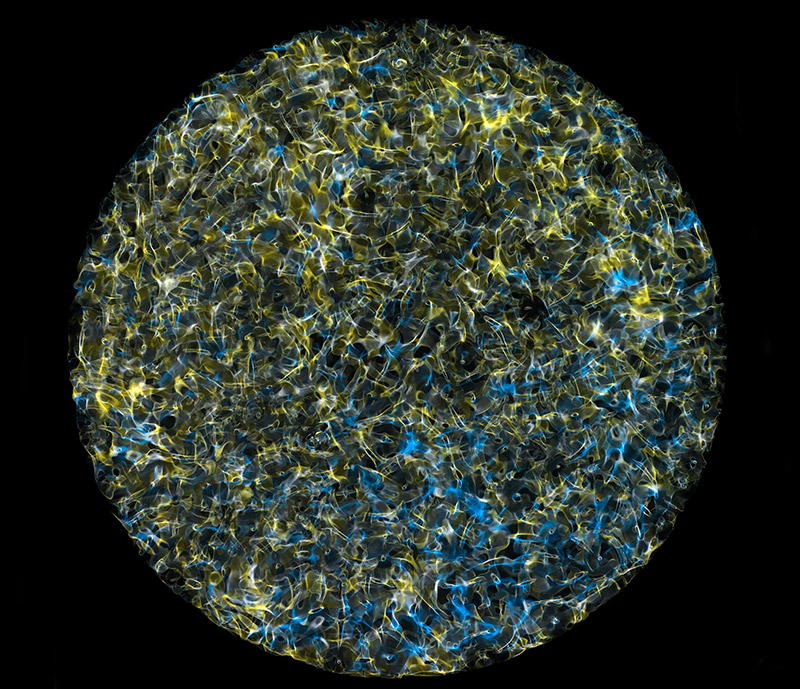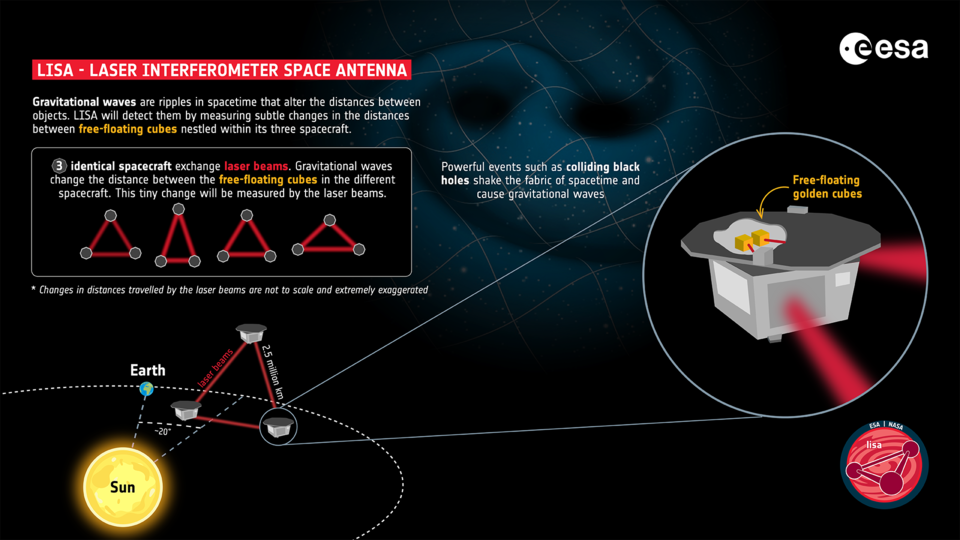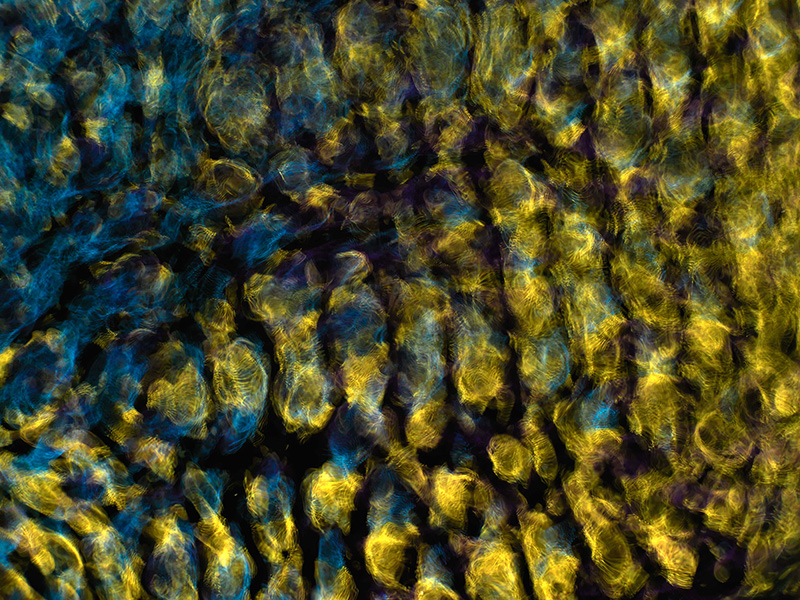Space-based Laser Interferometer Space Antenna LISA mission off world gravitational wave detector
Author: Distil Ennui | Post Date: 13-02-2024For the first time an off-planet gravitational wave detector in space will hunt for gravitational wave ripples in spacetime. So far we have all been watching the cosmos like a silent movie, capturing the ripples of spacetime with LISA one will be a real game-changer, like when sound was added to motion pictures.

image credit University of Florida (CC BY4.0)

'Cymatic Water & Light Plate 0864' June 2023.
Visualising gravitational waves with liquid, photography & physics alone, no AI or CGI.
available for stock photo licensing at UnderwaterImageLibrary.com.
The wave detector has received the go-ahead for funding and scheduling, increasing sensitivity to be able to read this important signature metric in space. The Laser Interferometer Space Antenna (LISA) mission, will consist of three spacecraft that together form a single detector, the project is a collaboration between NASA and the European Space Agency (ESA). Although launch will not be until the mid-2030s.

Image credit: ESA (CC BY4.0)
The adoption of LISA was announced by ESA on Jan. 25 2024, and recognises that the mission concept and associated technology are now sufficiently advanced. Getting the green light means scientists can start building the spacecraft as well as its required instruments; work will begin in Jan. 2025 after a European industrial contractor has been selected for construction.
The three spacecraft of LISA will trail Earth as our planet orbits the sun, forming an equilateral triangle in space. Each side of this triangle will be 1.6 million miles or 2.6 kilometres long. The LISA craft will fire laser beams at each other, each transmission will experience minute-long alterations as gravitational waves pass over them, squashing and squeezing the very fabric of space.

'Cymatic Water & Light Plate 0173' June 2023.
Visualising gravitational waves with liquid, photography & physics alone, no AI or CGI.
The Universe is mostly studied by measuring the amount and type of electromagnetic radiation emitted by massive objects in space. In 2015, Caltech & LIGO began to view the universe in a completely new way, by detecting and studying gravitational radiation for the very first time. According to Einstein's theory of general relativity, gravitational waves are caused by the acceleration of massive bodies, similar to the way that electromagnetic waves are produced by the acceleration of electrically charged bodies. But gravitational waves are waves in the ocean of spacetime itself, stretching and compressing both space and time as they pass by. Although these "ripples in spacetime" are produced any time a massive object (like you) accelerates, spacetime is incredibly stiff, so only extreme accelerations of very massive bodies can produce discernible ripples that are detectable.

'Cymatic Water & Light Plate 0208' June 2023.
Visualising gravitational waves with liquid, photography & physics alone, no AI or CGI.
available for stock photo licensing at UnderwaterImageLibrary.com.
Current photography used to explain the project, its findings and the theory behind it are all images rendered in CGI or AI. After working with water as a primary medium for the past 40 years, I realised that much of the physics in my work and that of cymatic, faraday or standing waves theory in liquids have a direct correlation to gravitational waves. So in the studio I began work on a new body of work to help visualise Einsteins's 1916 General Theory Of Relativity. The entire collection of over 1000 images from the series 'Cymatic water & light' is available for viewing and stock image licensing at the Underwater Image Library. These images help Illustrate the science behind the theory with visually relevant imagery using only physics, liquids and a camera. You can view a selection of 50 images from the collection at 'Cymatic Water & Light (2023 - Ongoing)', with a downloadable PDF catalogue of availble framed artworks here.

'Cymatic Water & Light Plate 0092' June 2023. a farady (standing) wave captured on analogue 5x4 inch film plate.
Existing gravitational wave detectors, like LIGO, VIRGO, and others, are enormous ground-based facilities designed to detect gravitational waves produced when small dense objects, like black holes and neutron stars left behind by a core-collapse supernovae, spiral together, accelerating faster and faster, as they generate increasingly rapid fluctuations in spacetime. But black holes come in super-sizes, clocking in at millions or even billions of times the mass of the sun. How did they get so big? Gravitational radiation can provide the answer to this fundamental question by determining how often these monsters accrete either other monster black holes or the smaller variety.

'Cymatic Water & Light Plate 0731' June 2023. access these images for photo licensing at UnderwaterImageLibrary.com.
Mergers with supermassive black holes produce longer-wavelength gravitational radiation, a wavelength range which cannot be detected by existing ground-based facilities. The Laser Interferometer Space Antenna, or LISA, is a space-based facility consisting of three satellites flying in a triangular formation (as shown in the illustration above), and will be sensitive to these long-wavelength gravitational waves by precisely measuring the separation between the three satellites incredibly precisely over distances of 2.5 million kilometres. This long baseline makes lets LISA detect low-frequency rumbles produced by mergers of supermassive black holes in distant galaxies, along with gravitational radiation produced by accelerations of white dwarfs, neutron stars and black holes in the Milky Way. LISA has been in development for more than a decade, and a pathfinder successfully showed the feasibility of the many cutting-edge technologies needed for LISA to succeed. This year, the LISA mission passed an important review of its feasibility, and the Science Programme Committee (SPC) of the European Space Agency has adopted LISA into its program of established future missions. This key step confirms that the development of LISA can proceed as planned, with launch of LISA planned for the mid-2030s. LISA is a collaboration between ESA and NASA, and an international LISA Consortium.
supporting data & references courtesy https://heasarc.gsfc.nasa.gov & https://www.space.com
now that you are here, please lets stay connected...
Join the mailing list.. Register
Telegram Channel.. DistilEnnui
Instagram.. DistilEnnuiStudio
Twitter.. DistilEnnui